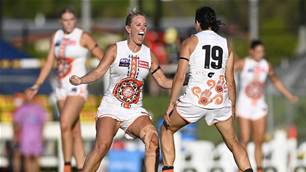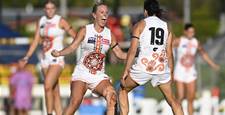The Footy Almanac have shared another extract from their latest publication in line with some of the recent commentary surrounding AFLW.
My (not very good) excuse is that women’s footy was so totally invisible that I didn’t know it existed, and I also wasn’t aware of the issues of exclusion that women in that field were battling, with incredible persistence and determination for many years.
It wasn’t until about 5 years ago that a friend took me to a local suburban women’s footy game, and I cried all the way home in the car because I realised that I had missed something in my life that would have been an enjoyable, positive, and wonderful experience – to both play the game (which I would have loved to do at any level in my younger days but didn’t know that you could), and then being part of a club and its supportive community later in life.
I’m making up for it in a small way now by contributing in all ways available to my limited skill set – including writing for this esteemed people’s organ; joining as a foundation member of the Crows and South Adelaide women's teams; telling anyone who wants to listen about the joy of seeing an emerging generation that are making us oldies look lazy, disengaged, and not-brave (bless you Florida kids); and yelling myself silly at every AFLW and SANFLW game that I can get to.
How was it that a particular demographic in our society (which in this case was half the population) were not allowed to play a particular sport? If it was decreed that Hindus, or indigenous people, or boys with red hair, or people who drive Fords, or live in a particular postcode, were not allowed to play hockey or badminton, or be doctors or nurses, for no reason other than their demographic profile – we would never let it happen, and there would be justifiable protests to human rights or equal opportunity agencies.
So how was it that after the age of 12 (initially) young women were not allowed to play footy – and if somehow they did covertly establish teams, they would be battling for recognition, be excluded from access to playing grounds, facilities, and basic club resources, be perceived with hostility and derision, and be totally invisible in the media (as if they were some dangerous underground cult that should not be spoken of publicly for fear that young girls’ ears might fall off).
Why was it that in a generally inclusive, democratic society that prides itself on giving everyone a fair go, three high school girls had to take the footy authorities to the High Court of Australia (!) to be allowed to continue to play footy with the boys.
I’m sure they would have preferred to play in a female junior league, but of course there wasn’t one.
How did this happen in 1990’s Australia? I’m still trying to figure that out – and I want to figure it out cos I want to make sure that I’m not sitting by ignorantly while it happens to other groups in relation to other activities, whether that be access and participation in sport, in the arts, in politics, in business, in education, or any other function or sector in our society.
Related Articles

Updated: AFLW Round 2 preview and schedule

Socceroo star's message to kids: Don't be an AFL player

.png&h=600&w=850&c=0&s=1)











